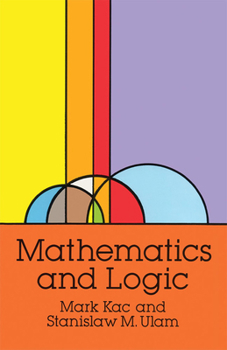Mathematics and Logic
Select Format
Select Condition 
Book Overview
What is mathematics? How was it created and who were and are the people creating and practicing it? Can one describe its development and role in the history of scientific thinking and can one predict the future? This book is a thought-provoking attempt to answer such questions and to suggest the scope and depth of the subject.
The volume begins with a discussion of problems involving integers in which ideas of infinity appear and proceeds through the evolution of more abstract ideas about numbers and geometrical objects. The authors show how mathematicians came to consider groups of general transformations and then, looking upon the sets of such subjects as spaces, how they attempted to build theories of structures in general. Also considered here are the relations between mathematics and the empirical disciplines, the profound effect of high-speed computers on the scope of mathematical experimentation, and the question of how much mathematical progress depends on "invention" and how much on "discovery." For mathematicians, physicists, or any student of the evolution of mathematical thought, this highly regarded study offers a stimulating investigation of the essential nature of mathematics.
The volume begins with a discussion of problems involving integers in which ideas of infinity appear and proceeds through the evolution of more abstract ideas about numbers and geometrical objects. The authors show how mathematicians came to consider groups of general transformations and then, looking upon the sets of such subjects as spaces, how they attempted to build theories of structures in general. Also considered here are the relations between mathematics and the empirical disciplines, the profound effect of high-speed computers on the scope of mathematical experimentation, and the question of how much mathematical progress depends on "invention" and how much on "discovery." For mathematicians, physicists, or any student of the evolution of mathematical thought, this highly regarded study offers a stimulating investigation of the essential nature of mathematics.
Format:Paperback
Language:English
ISBN:0486670856
ISBN13:9780486670850
Release Date:May 1992
Publisher:Dover Publications
Length:192 Pages
Weight:0.49 lbs.
Dimensions:0.4" x 5.7" x 8.2"
Customer Reviews
5 ratings
Excellent overview by two outstanding mathematicians
Published by Thriftbooks.com User , 20 years ago
The audience for ths book is people with background in mathematics. They teach many branches briefly with their examples in Chapter 1, but the presentation is at a fairly sophisticated level.I found the historical and philosophical remarks very valuable, coming from authorities like these two men. Examples (slightly edited by me):The great analysts of the 18th and 19th centuries (e.g., Newton, Leibniz, Bernoulli, Euler, Lagrange ...) had an almost unerring instinct for presenting valid results and plausible proofs without a firm basis in formal systems and without strict adherence to standards of logical rigor... Mathematical intuition in the hands of people of genius has such a clarity and unity that it anticipates special formalisms.Mathematics is a science; it is also an art. The criteria of judgment in mathematics are always aesthetic, at least in part... One looks for `usefulness,' for `interest,' and also for `beauty.' Beauty is subjective, yet it is surprising that there is usually considerable agreement among mathematicians concerning aesthetic values.It is a distinctive feature of mathematics that it can operate effectively and efficiently without defining its objects. Points, straight lines and planes are not defined... One need not know what things are so long as one knows what statements about them one is allowed to make [the axioms]... Other statements involving these undefined words can then be deduced by logic alone. This permits geometry to be taught to a blind man and even to a computer!
A Classic of Popular Mathematics
Published by Thriftbooks.com User , 23 years ago
With new mathematics growing wild in the trees in the new century, one should review those things that have given modern mathematics direction and flavor. This classic little book sits along side of Sawyer's " Prelude to Mathematics" as the go to books for basic understanding. To these books I have added an unlikely candidate " Elliptical Curves" by McKean and Moll. If one has these three books, he will have a crack in the dam of mathematics...
Important and Useful but not Engaging
Published by Thriftbooks.com User , 23 years ago
The book shows what the power of mathematics is, how it changes, and how it expands to new areas. Unlike books that aim to popularize math, the book does not pontificate a mystic view of the meaning of mathematics; rather, it gives a sober perspective of what has happened in mathematics and what can be expected of the field.The book requires somewhat serious mathematical thinking.A great strength of the book is the diverse mathematical concepts that it presents: homology groups, group theory, Turing machines, undecidability, Monte Carlo method. In a compact book, you learn a little about some important ideas in advanced mathematics.Important!! This book is not written to popularize its subject matter, so it is different and definitely less entertaining than most popular science books.
why math is interesting, written for laypeople
Published by Thriftbooks.com User , 24 years ago
Kac and Ulam were both strong mathematicians; this encyclopedia article which they coauthored provides a nice counterweight to the answers-without-questions view of math which can result from a little indifferent coursework.Easy and lively reading, written for everyone.
A bargain indeed
Published by Thriftbooks.com User , 25 years ago
Just read the editorial review (Book News). It's all true (except for the publishing date, which is 1968, not 1986...)





